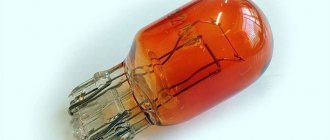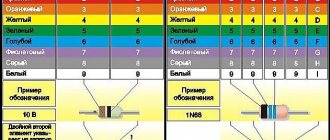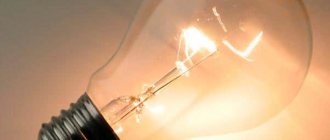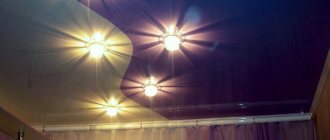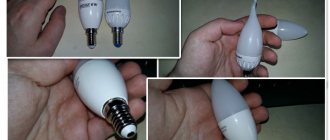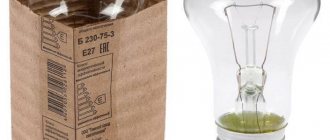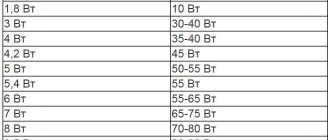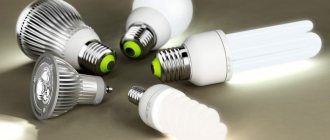How is marking done?
The marking is a combination of a letter or several letters at the front and a number at the end.
The type is determined by the letter in front:
- E – threaded type base (sometimes the name Edison screw is also found);
- G – Pin base;
- R – Base, which has recessed contacts;
- B – Pin type base;
- S – Soffit base;
- P – focusing type base;
- T – Telephone socket;
- K – Cable socket;
- W – baseless lamp.
Also, after these letters, information about the subtype of lamp that is used may be indicated:
- U – Light bulb operating in energy-saving mode;
- V – Base, which has a conical end;
- A – Car lamp.
The letters are followed by numbers that indicate (in mm) the diameter of the base or the distance between its contacts. If after you see another letter, this is the number of contacts (s means 1, d – 2, t – 3, q – 4, p – 5).
Why does a light bulb need a base?
A base is a structural element of an electric lamp, with the help of which it is installed and secured in the socket of a lighting device. Lamp bases have several purposes:
- provide power to the light bulbs through the conductive contacts provided by the design;
- “responsible” for the safe and simple change of light bulbs in devices when they fail;
- seal lamp bulbs, inside of which inert gases are pumped or a vacuum is created.
Socles are special blocks or boxes in which conductive contacts are completely hidden. Only the pins, wires or plates that are needed to conduct electricity from the cartridges to the diodes or filaments are brought out.
Bases can be metal, ceramic or plastic; their contacts are usually made of refractory metals. In modifications where the functions of the base are taken over by the bulb itself, the body of the lighting fixture is usually made of glass.
Features and application of some types of lamp bases
Screw base E
The labeling of this group is quite simple. It includes the letter “E” and the designation of the body diameter. For better compatibility, you can often find special adapters that make the job much easier. The most popular sockets of this type are E10 , E14 , E27 , E40 . This subspecies is used for both incandescent and energy-saving and LED lamps. The most popular are the classic E27 and E14 . The largest type is used for lighting large areas - streets, parks, industrial buildings.
How to correctly replace the cartridge in a chandelier?
To repair the cartridge, you need to disassemble it, check the connection and clean the contacts. To disassemble the device, you need to pull out the ceramic base and disconnect it from the contacts. When this base breaks, it must be replaced. Then the wires are connected.
You should check how securely the phase contact is fastened. To do this, place the lamp base and make sure that the contact bends by at least 2 mm.
The last step is to screw the casing onto the bottom.
Characteristics of popular types of lamp sockets
Base E14
Everyone's favorite popular "minion". Suitable for many types of light bulbs, used for both decorative and regular lighting. It is most often consumed under incandescent lamps, since the energy-saving option is more expensive. Also, do not forget about the LED variety , which does not have the disadvantages inherent in the lamps mentioned above. Due to their compactness, “minions” are widely used, because they can be inserted into almost any lamp or chandelier.
Base E27
The properties are the same as the above-mentioned E14, differing from it only in its more ancient history of origin and greater popularity. Regarding versatility, both designs are almost the same, because in case of emergency there are a countless number of special adapters.
Base G4
Designed for voltage from 12 to 24V, the estimated service life is up to two thousand hours. Designed for very miniature halogen light bulbs, which play an exclusively decorative role in lighting.
Base G5
Unlike its smaller subtype, it is also designed for LED lamps. They are often used in a suspended ceiling for local lighting of individual elements of the interior decor of a room.
Base G9
They are distinguished by their operation without transformers; they are used in a regular 220V network. They are installed in many lamps and chandeliers, the lamps are usually halogen (then the base part is made of glass), but there are also LED variations (in this case the glass is replaced with plastic). They occupy the second most popular place after the Edison screw.
Types of lighting bulbs
We will talk about the most common lamps that we usually use at home, in offices and various industrial premises. These include incandescent, energy-saving, halogen, fluorescent and LED lamps. Let's look at each of these types in more detail.
Regular incandescent lamp
This is probably the most common lamp, despite the fact that it is already more than 150 years old, and over the past 100 years it has undergone virtually no significant changes, we still use it. The thing is that its production is very cheap and its design is simple. It is a flask without air in which a tungsten filament is placed. Under the influence of electric current, it heats up to high temperatures and emits light. Modern incandescent lamps with a tungsten filament have one feature: at room temperature, the resistance in the tungsten filament is very low, approximately 15 times lower than the working one, which increases the risk of its burning out when a higher current passes at the moment of switching on. The first lamps used graphite filaments, the resistance of which, on the contrary, decreased with increasing temperature. This gave the effect of a gradual increase in brightness. At the same time, graphite threads exhausted their service life faster.
The device of the simplest incandescent lamp
In terms of their technical characteristics, incandescent lamps are much inferior to other types of lamps. The lifespan of a typical light bulb is approximately 1000 hours. It is noteworthy that the fire department of the small town of Livermore, California, has a light bulb that has been continuously lit since 1901. This, of course, is an exception to the rule. In addition to their short service life, incandescent lamps become cloudy over time due to the vapors formed in the bulb. This greatly reduces their luminosity. Incandescent lamps produce yellow light, which is close to the spectral characteristics of sunlight. Almost all incandescent lamps are produced with E14 and E27 sockets. The exception is small light bulbs, which a couple of decades ago were screwed into lanterns and Christmas tree garlands. Today it is already difficult to find a socket for such light bulbs.
Among lamps of this type there are special reflector lamps. Their distinctive feature is the silver-plated inner surface of the flask. Such devices are used to create a beam of directional light when it is necessary to illuminate an object. On store shelves there are reflector lamps that are marked R50, R63 and R80, where the number is the diameter of the lamp. As for the base, it is the same as for simple incandescent lamps. Some bulbs have frosted glass to produce more diffused light. There are also multi-colored lamps used to create various lighting effects.
Halogen lamp
This bulb can last about four times longer than a regular incandescent bulb. Manufacturers claim that its service life can be about 4000 hours, and the so-called color rendering index is 100%. In its design, such a lamp is not much different from a regular one, but vapors of substances such as iodine or bromine are added to the flask. This greatly increases light output and service life. Modern halogen lamps have a luminous efficiency of 20-30 lm/watt, which is maintained throughout the intended service life and is not lost over time, like a conventional incandescent light bulb.
Halogen lamps
Most often, halogen lamps are much smaller in size than regular lamps. They have many different shapes, and the bases are: G9, G4, R7S, GU10. There are even halogen lamps built into the bulb of a regular light bulb with an E27 base.
Halogen lamp with E27 base, made inside a regular bulb
Halogen lamps have one drawback - low-frequency noise when used in conjunction with dimmers that control luminosity. This type of lamp is most widely used in the automotive industry. Modern car headlights are equipped with halogen lamps.
Fluorescent tube lamps
These light sources have a characteristic elongated tube shape of varying lengths and diameters. The latter is indicated by the letter T on the marking. For example, T12 (diameter 12/8 inch=3.8 cm). Such lamps require special lamps with a trigger. It is required in order to create an electromagnetic field inside the flask that can cause the phosphor to glow under the influence of mercury vapor. Such lamps do not have incandescent parts, which greatly increases their efficiency and efficiency, since the need to heat the substance disappears and almost all the energy is converted into luminous flux. The sockets of this type of lamp are most often pin-type and are located on both sides of the bulb.
Tubular fluorescent lamps
Energy saving types of lamps
This term is usually used to refer to small fluorescent lamps. Today they have gained high popularity, as they can reduce energy costs very significantly. They are sold in any stores, and installing them in a regular threaded cartridge is not a problem, since they are equipped with the same sockets.
Energy saving lamp
Thanks to modern technological developments, energy-saving light bulbs have very compact sizes, various power variations, a wide variety of shapes, but definitely a long service life and extraordinary efficiency. However, it must be remembered that such lighting devices “do not like” being turned on and off too often, and also, like all fluorescent lamps, require special disposal conditions, since the mercury vapor they contain is very dangerous to humans and the environment. Today there are energy-saving lamps with any type of base: E14, E27, GU10, G9, GU5.3, G4, GU4.
LED bulbs
They can also be called “energy saving”, but this is not their main advantage. With significant energy savings, they have a truly enormous service life, which can amount to tens of thousands of hours and years. An LED lamp will last from 25,000 to 100,000 hours, which equals 3-12 years of continuous operation. In addition, their light output is almost one hundred percent. LEDs do not use heat, so such lamps are completely safe in the fire sense. Most LED lamps are equipped with standard sockets, which allows them to be used in any luminaire. They are completely environmentally friendly, as they do not contain any harmful substances.
LED bulbs
The only disadvantage that should be noted is the very high cost. This, of course, is compensated by a very long service life. It is not recommended to purchase cheaper LED lamps, since due to the savings on capacitors, they glow with invisible flicker, which in a hidden form affects vision. Another disadvantage is the blue-shifted emission spectrum, which does not correspond to natural sunlight. LEDs shine with a rather cold, unnatural light.
Using energy-saving lighting sources allows you to save a lot on electricity. At the same time, when purchasing them, you should be careful when choosing a manufacturer and buy only well-known models, since otherwise many of the advantages become not so obvious.
Varieties
You cannot choose LED lamps for your car based on the principle that the brightest ones will be the best. Here you need to take into account different selection criteria, technical characteristics and design features of your own machine.
Only based on basic information can we say which LED lamps will be better and what is worth buying for a car so that the lamps work efficiently, help the driver and do not disturb other road users with their glow.
How brightly the LED lamps will shine depends largely on where on the car they are installed. It is logical to assume that the brightest devices are those that work on low and high beam headlights. But this is not a complete list of where LEDs can be used in a car.
LED devices according to their intended purpose can be divided into the following categories:
- Low beam. If you install low-beam diode lamps, you will be able to obtain maximum lighting quality. Here LED is noticeably superior to its halogen counterpart. The light will not be yellowish, but cleaner, closer to natural.
- High beam. No less relevant are high beam lamps made using LED technology. In fact, these are compact panels consisting of LEDs. They fit into a standard headlight reflector and provide effective illumination over long distances.
- Dimensions and signal lights. These devices have low power consumption. They efficiently consume electricity from the on-board network, but at the same time guarantee clear, bright and long-lasting operation. LED dimensions and warning lamps are more noticeable during the daytime compared to competitors.
- Fog lights. There are also fog lamps using LED technology. In practice, it has been proven that their efficiency is higher in comparison with PTF made from halogen lamps. Plus their energy consumption indicators are lower. The quality of light is high.
- Salon lighting. Increasingly, diodes have begun to be installed in the interior from the factory, illuminating various elements, providing light in the cabin, and so on. Plus, LED strips have become widespread. Motorists themselves decorate the car interior with them, creating illumination of different colors and a wide light spectrum. Beautiful, practical and convenient.
GH53
Lamps with a GX53 base are perhaps the most successful solution for installation in built-in spotlights for a suspended or suspended plasterboard ceiling.
They have a small depth - from 15mm, which allows them to be installed even in small spaces. At the same time, they have a large diameter, on average 75mm. Such a lamp is almost entirely on one side - a light-emitting surface, which is very effective in lighting. The large surface diameter also allows this light source to be effectively cooled, making it last longer.
The pin contacts here have thickenings at the edges, thereby allowing the light bulb to be securely fixed in the lamp socket during installation.
Type : flat diffuser
Standard size: Diameter 75mm, depth from 15mm
Application: Lamps with GX53 socket are often used for decorative lighting, but most often, due to their qualities, they are elements of main lighting. A group of such lamps replaces traditional chandeliers, creating more even illumination of the room.
Marking GX53: GX – pin contacts, distance between contact axes 53 mm.
How to choose ceiling lights
When purchasing, pay attention to the following features:
- type of lamps - preferably LED;
- “age” of the model - the more modern the design, the less space it takes up in the inter-ceiling space;
- shape - some experts prefer round lamps, because they believe that square mortgages and thermal rings cope worse with the load, and the properties deteriorate with increasing size of the device;
- marking for bath fixtures must be at least IP44, and the higher the rating, the better the protection against moisture penetration;
- the width of the “skirt” of the recessed lamp - choose at least 1 cm, otherwise the thermal rings will be visible;
- angle (depending on the tasks) - creates a directed beam or diffused light flux;
- design - must be in harmony with other lighting fixtures and with the interior as a whole.
They also pay attention to the manufacturer. You should not buy counterfeit goods in an attempt to save money. Products from an unknown manufacturer will most likely last much less.
It is easier to choose a mounting platform and rings for round devices, a little more difficult for square ones. The most expensive installation is rectangular spot models with several bulbs.
Some devices are powered from a 220V network, others are low-voltage - 12V or 24V. The former are installed in ordinary “dry” rooms, the latter are also suitable for places with high humidity - baths, saunas. For low-voltage devices, the circuit includes a transformer that converts standard household voltage.
Rating of the best LED lamps for cars
After studying the characteristics of the models and customer reviews, a rating of the best LED lamps for cars was compiled.
Bullvision H11 H4 H7 Led 12V Mini 9005 9006
The top includes an LED lamp for head and fog lights.
Basic properties:
- Brand: Bullvision;
- country of origin: China;
- price - 744.63-10121.66 rubles;
- power - 120 W;
- color temperature - 6000K;
- LED Chip - CSP chip;
- input voltage - 12 V;
- Warranty period - 2 years.
OSRAM 9012 HIR2 HB2 H11 H7
Osram optics are suitable for any vehicle: car, truck, motorcycle. Its products are included in the top LED lamps for cars. They are used as high and low beams.
Characteristics:
- brand - Osram;
- country of origin: China;
- price - 4,013.57 rubles/set;
- power - 19 W;
- color temperature - 6000 K;
- voltage - 12 V.
G6.35
Light sources with a G.6.35 socket are analogues of the G9 models presented above. The main difference is that the contacts are made in the form of pins, not loops. Initially, the connection and the cartridges themselves for such a base were considered less reliable. Therefore, they were used in lighting devices with 12-24 V halogen bulbs, through a step-down transformer. Now, in the era of LED technologies, they successfully operate at a voltage of 220V.
Standard size : Bulb diameter 13-18mm, height from 40mm
Type: Volumetric lamp, capsule type
Application: In spotlights for decorative and accent lighting.
Marking G6.35: G – pin contacts, 6.35 – distance between the axes of the contacts in mm.

